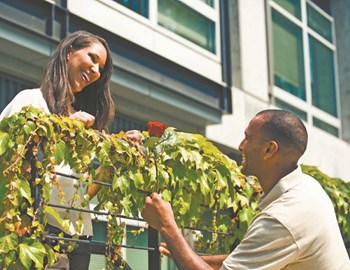
Ever since Romeo and Juliet made them famous, balconies have been popular additions to our homes and living spaces. For condominium and HOA communities, balconies can add visual zest, as well as a few more feet of living space that allow us to enjoy the outdoors and some time in the sun.
As with any structure, balconies need a care and maintenance to look their best and last their longest. What goes into caring for balconies, and what happens when they need fixing? With proper planning and the right tools, maintenance and repair can add years of enjoyment and value to your HOA’s balconies, as well as keeping them safe for residents and their guests.
How They Work
For the most part, balconies are built out of steel and concrete these days, with a few wood-and-steel models mixed in here and there. According to Stan Wellinsky, vice president of Valcourt Building Services LLC in Elizabeth, there are two kinds of concrete balconies: continuous slab, which are simply an extension of a building’s concrete floor, and those with steel frames mounted to the structure’s exterior, with planks extending outward from the building’s frame and filled with concrete. On both types of balconies, railings are added after initial construction and are either embedded into the balcony or surface mounted.
Keep them Looking Good
Concrete balconies “should last forever, with proper routine maintenance,” Wellinsky says. Without proper maintenance however, “I’ve seen them develop problems in 10 years or less.”
Proper maintenance starts with establishing a baseline for a balcony or porch’s materials and conditions and knowing how they age each year. “The maintenance man should do a visual inspection, documenting any problems he sees,” says Wellinsky. “If there’s a crack two inches long, he should record it on a spreadsheet. That establishes a benchmark early on.”
With that baseline or benchmark established, the maintenance person can check back during the next inspection and see if the crack has grown or changed in any way. “If you can catch it early, there are things that you can do to slow it down. If you wait too long, it can get serious,” Wellinsky says.
Most associations will have a set time each year or half a year when they’ll do the visual inspection of the property, checking for outward signs of age or disrepair. “It’s up to the association to determine how often that’s done,” says James Magid, regional vice president of Wentworth Property Management in West Long Branch. For balconies, “it might depend on what they’re made of, how accessible they are and how often they’re used.”
Depending on the community and its rules, the responsibility for maintenance and repair of balconies could fall either to the unit owner or to the association. Typically, because of how limited common elements are outlined in the governing documents, responsibility for larger structural issues falls to the association. According to Magid, [Things like] washing and painting and minor repairs typically are up to the unit owner, but it all depends on what the association originally determined” when the original developers were setting up the community’s governing documents.
Where Problems Arise
So what can the caregivers of balconies expect in terms of trouble over the long term? One of the most common ailments afflicting concrete balconies is corrosion. When the steel inside the concrete is exposed to oxygen, it expands. “That cracks the concrete and causes it to fall apart,” explains William Schutt, president of Philadelphia-based corrosion control company MATCOR, Inc. This is why regular visual inspections are so vital, particularly for older buildings. “At the ten year mark, [inspectors and residents] need to be looking for signs of corrosion,” Schutt says. “They may see rust stains. You shouldn’t see rust stains on your concrete, or find little loose pieces.”
For those living near the shore, salt can also cause corrosion. “Especially near the ocean, salt can enter concrete and create an acidic situation,” adds Schutt. “The concrete will then corrode the same way your car would corrode more on the shore than inland.” Once corrosion starts, it can be difficult to stop. “It’s like a cancer,” he says.
Problems also may have started before the first resident even moved into the building. “Contamination might have occurred when the contractor built the balconies,” Schutt says. In older buildings, the contractors “may have added a concrete accelerator that contained salt.” Salt, in turn, causes corrosion.
Loose railings also can cause problems for residents. Embedded railings will have problems sooner than their surface-mounted brethren because of the penetration necessary to attach the railings. According to Wellinsky, if not properly sealed, those areas can collect moisture and cause rust and corrosion of the metal railings as well as the surrounding concrete.
Small pits resembling little potholes also can form in the concrete, and that causes issues as well. In addition to salt and water, indoor/outdoor carpeting can contribute to balcony decline, trapping moisture and not allowing the concrete to breathe. The same is true of certain watertight coatings.
It’s important, too, to keep track of what may seem like just cosmetic issues because they may be signs of larger structural problems. If things look dicey—if chunks of concrete are found on the ground or cracks are growing rapidly in size, management should bring in a structural engineer immediately to assess the situation and map out a repair plan. When it comes to balconies and their attending issues of safety, it is always better to be safe than sorry and turn to those who know these structures best.
Making it Better
According to Wellinsky, any of the abovementioned problems with concrete can be prevented—or at least postponed for many years—with regular annual cleaning or power washing. Maintenance crews should also be on the lookout for caulking that may need replacing, or places where sealant has deteriorated and is in need of a new application. Putting off basic care and prevention will only lead to costly trouble later on, so it’s essential to engage in an ongoing and thorough maintenance program.
If problems already exist, they may require chipping away old concrete and adding in new. If railings are an issue, some thought might go into switching out embedded railings for the mounted variety. Using protective coatings and rust inhibitors to prevent moisture penetration and quell the concrete-cracking issue of oxidation and rust also can be key in extending railing life. And keeping those railings secure is of paramount importance to the safety and well-being of residents.
Over time however, boards and management may grow weary of perpetual patching and calls to the structural engineer to check out potential problems with their community’s balconies. If that’s the case, there is an alternative solution—something called cathodic protection. It involves using a form of electrolysis to stop corrosion. “It’s a system that the federal government requires on gas and oil pipelines to stop them from rusting away,” says Schutt.
With this system, a low voltage electrical current—less than that found in a nine-volt battery—is placed in the concrete, raising the Ph level and lessening the acid around the steel reinforcements, preventing rust and in turn preventing corrosion. “The damage stops and the repair cycle stops,” Schutt says.
“If you’re just maintaining, you patch and repair, and it’ll just get worse,” Schutt says. Installing the cathodic protection during repairs will lessen costs in the long run, he adds, eliminating the need for repair crews to chip away at both bad concrete and good concrete as they search for the source of a corrosion problem. Having to dig to the source and then laying new concrete can get expensive. Schutt believes that installing a cathodic protection system will halt the progress of corrosion and save valuable time and resources later—something especially appealing to large, multi-unit associations.
With proper care and attention, a balcony can last years, providing a perfect oasis in which people can enjoy the outdoors and enjoy each other’s company. Every dollar spent on maintenance and repair will not only increase the satisfaction of ownership for happy residents, but it will ensure a safe environment that adds value to your community.
Liz Lent is a freelance writer, teacher and a frequent contributor toThe New Jersey Cooperator.






Leave a Comment